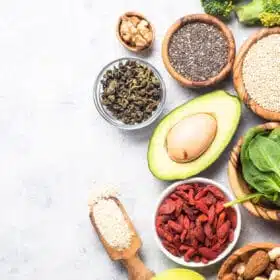Surely you have already seen different food pyramids. Depending on the philosophy of the researcher, scientist, or association in whose name it was created, these charts can differ significantly. An institute that advocates efficacy and priority of complex carbohydrates will have a different pyramid than one that advocates high-protein diets. The display board of Paleo food advocates will look different than that of vegan diet advocates. However, all pyramids serve to facilitate daily food choices and provide a quick overview of what to eat, in what amounts, and in what proportions. If you are very athletic and active, this food chart may be helpful for you:
The Fit Food Pyramid
1. non-starchy vegetables
Non-starchy vegetables include leaf lettuces, cabbage varieties, tomatoes, peppers, green beans, cucumbers and mainly vegetables that grow above ground. Mostly they contain a lot of water, which has a positive effect on the calorie balance. They provide you with antioxidants, flavonoids, vitamins and minerals. The fresher the produce, the higher the content of these ingredients. Field-grown or organic vegetables are of higher quality than products from large farms. You can eat your fill of spinach and the like without having to pay attention to the quantity.
2. protein/protein
Whether you play sports or not, your body needs high-quality protein every day to get all the amino acids it needs. If you are very active, your needs can double (1 - 2 grams of protein per kilo of body weight). You should consume protein every four hours so that your body does not fall into a state of deficiency and have to pull on your hard-earned muscles. You can get animal protein from meat, fish, eggs and dairy products. Vegetable protein can be found in nuts, soybeans (tofu) and grains. Because vegetable protein does not have the full spectrum of amino acids, it is considered to be of lower quality. However, with a little nutritional knowledge and clever combinations, you can also complete plant protein.
3. whole grains and starchy vegetables
In third place are whole-grain products and starchy vegetables. Whole-grain products include oatmeal, muesli, whole-grain bread, brown rice and cooked cereals. Starchy vegetables include potatoes, lentils and peas. Since we are already at the top of the pyramid here, the daily intake should already be well thought out. These products contain a lot of carbohydrates, which can get in the way of your fitness goals. However, they are important because they provide you with many beneficial ingredients (minerals, vitamins, protein, fiber). Complex carbohydrates keep your blood sugar in check and prevent cravings caused by insulin spikes.
4. fruit/fruits
Fruits provide you with vitamins, water, antioxidants and more. Of course, they also taste great. The reason fruits are at the top of the pyramid is because they can contain a lot of sugar. Fructose, however, can negatively affect your blood sugar levels. Especially if you squeeze them and use them as juice. The glucose they contain can cause a real blood sugar shock, which is certainly not good for you. If you use fruits, you should enjoy the whole fruit with the complete pulp.
5. fats and oils
It would be a big mistake to completely avoid fat in your diet. Your body needs fats for many tasks. Some vitamins are fat-soluble, which means that they cannot be utilized without a certain amount of fat (Vit. A in carrots). Fat even helps you lose weight. Extremely low-fat diets cause constant hunger and bad mood. You should eat at least two tablespoons a day. You can get "good fats" from avocados, olives, fish, flaxseeds and nuts. These foods contain many unsaturated fatty acids, which have a positive effect on your health.
6. refined carbohydrates
At the top of the fit food pyramid are refined carbohydrates. This means that you should consume minimal portions of them every day. Empty carbohydrates are found in highly processed foods such as sweets and baked goods. Eating them doesn't give you any health benefits because they don't contain any nutrients worth mentioning. Unfortunately, they are also often full of sugar and fat. You don't have to completely eliminate this group of products from your diet. What you forbid yourself to eat always seems extremely appealing. If you consume a lot of calories, they won't destroy your fitness goals if enjoyed in small amounts. However, choose them wisely.
With a good food pyramid, you can get a quick overview of where the focus of your food choices should be. You can individually calculate how big your daily portions should actually be based on your calorie consumption and activity level. However, if you don't want to be too precise, just follow the lower levels. Then you are already on the right track!




